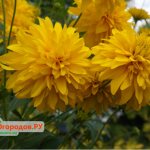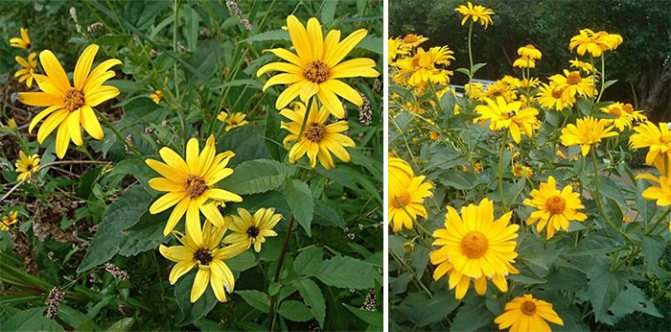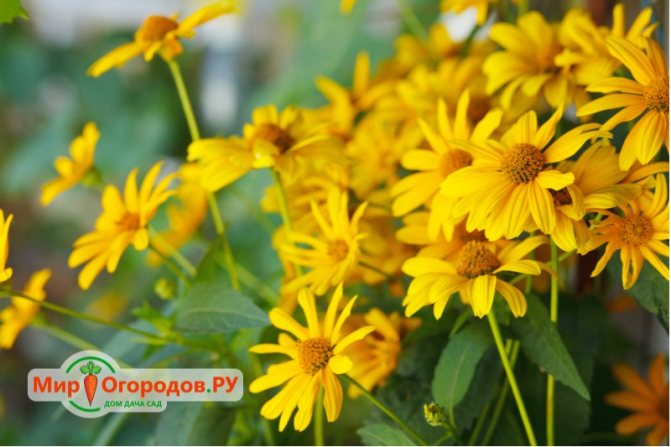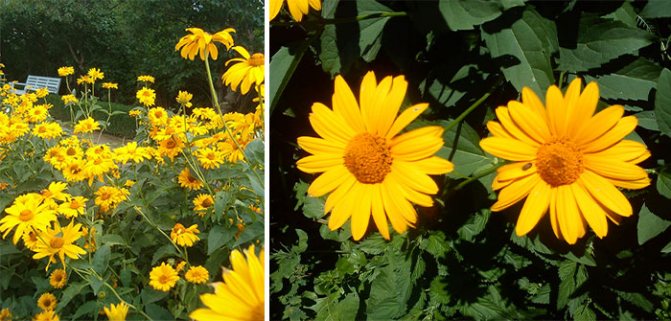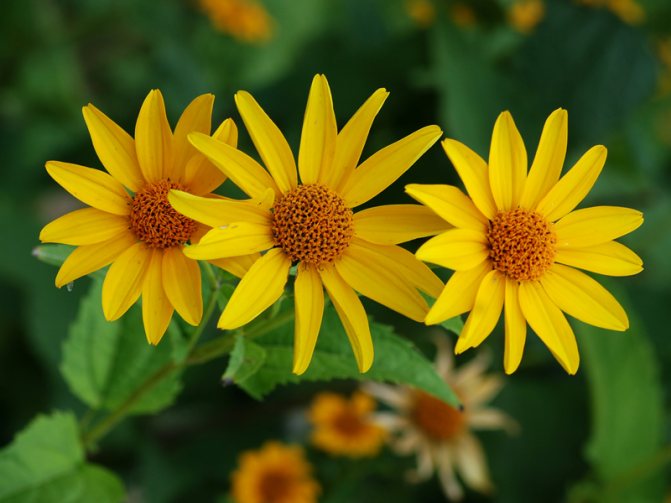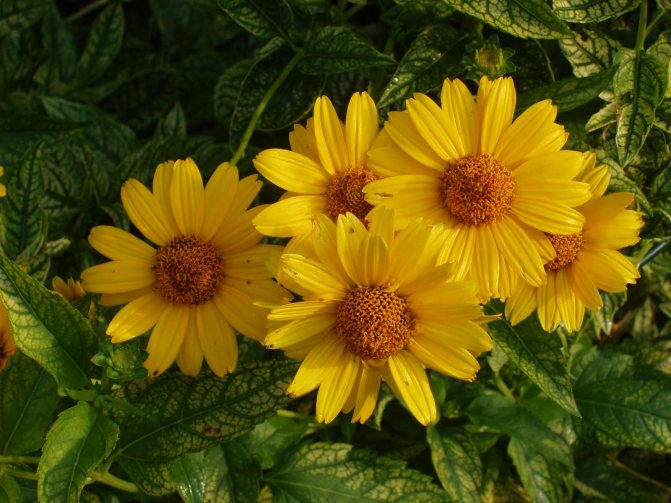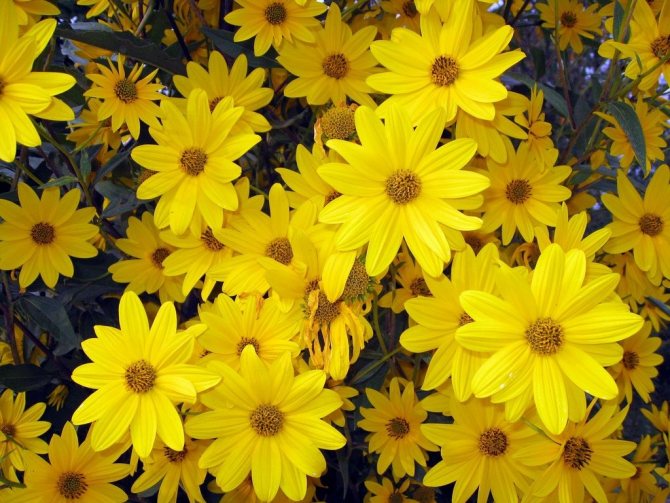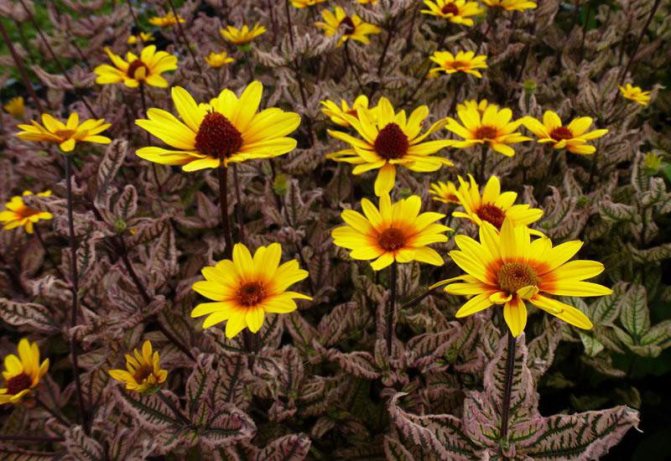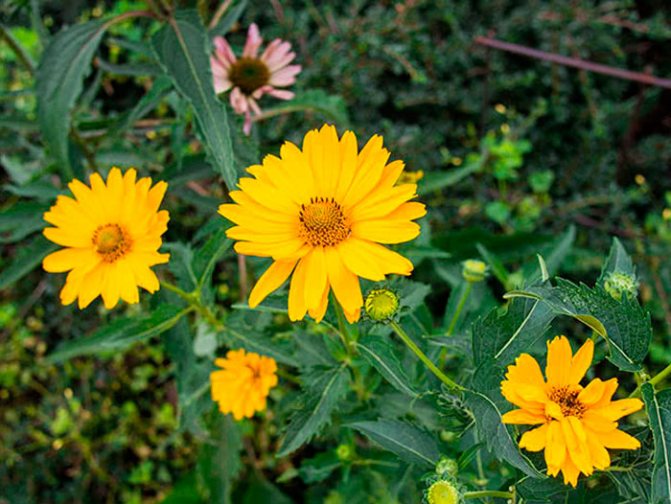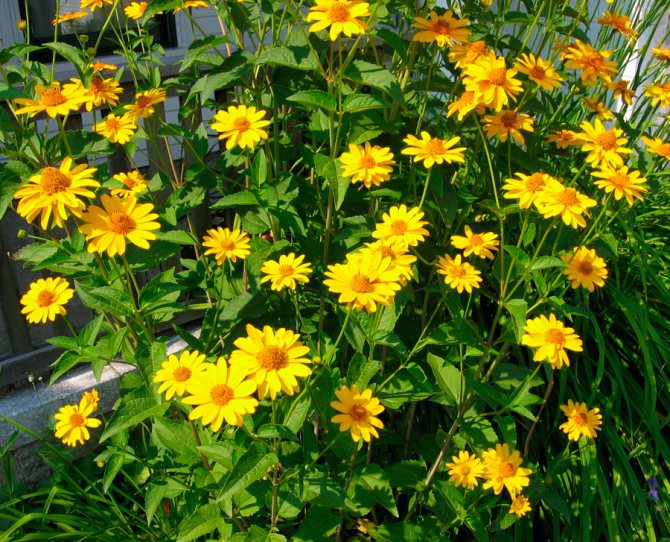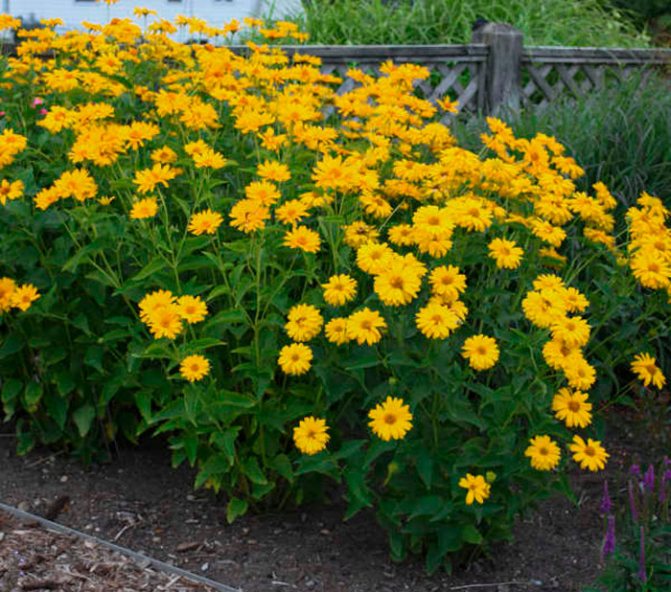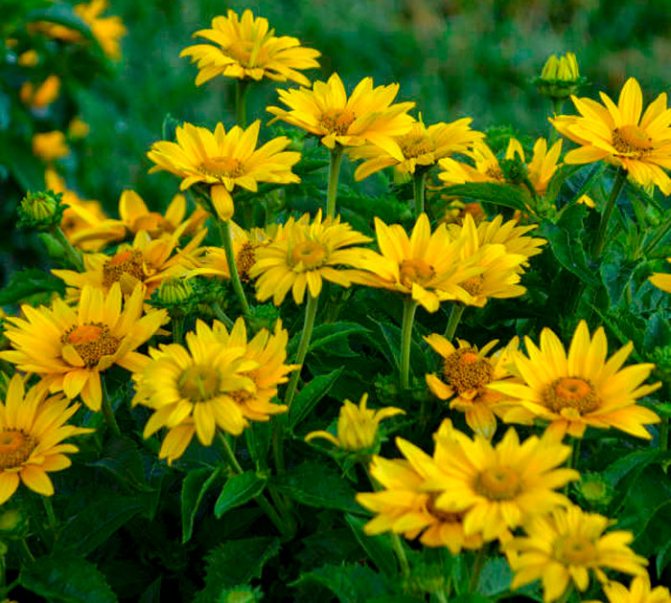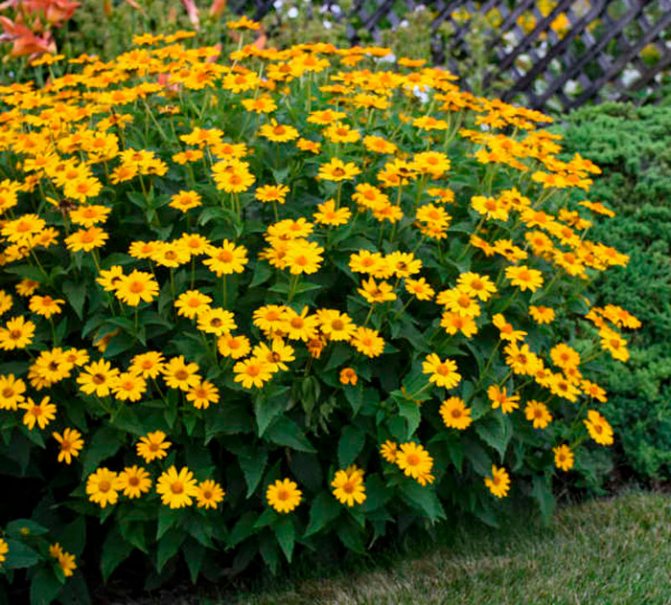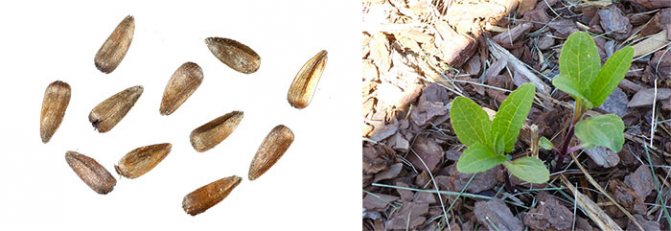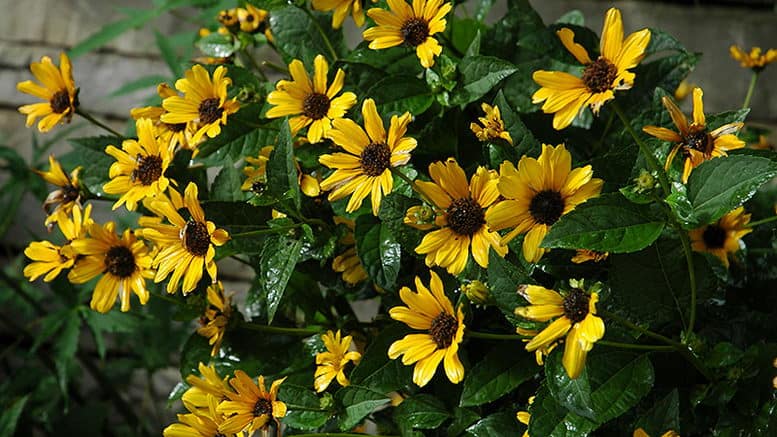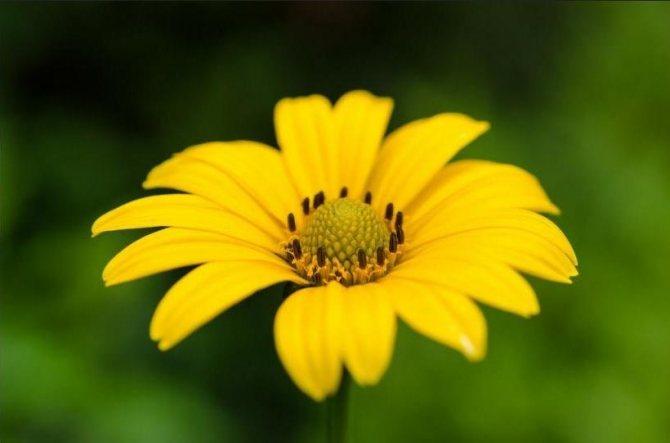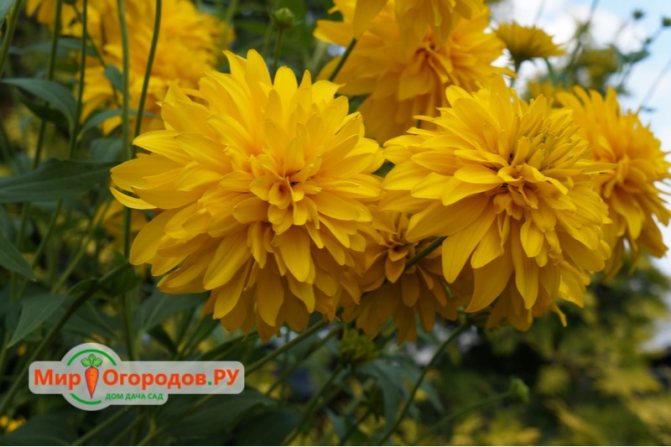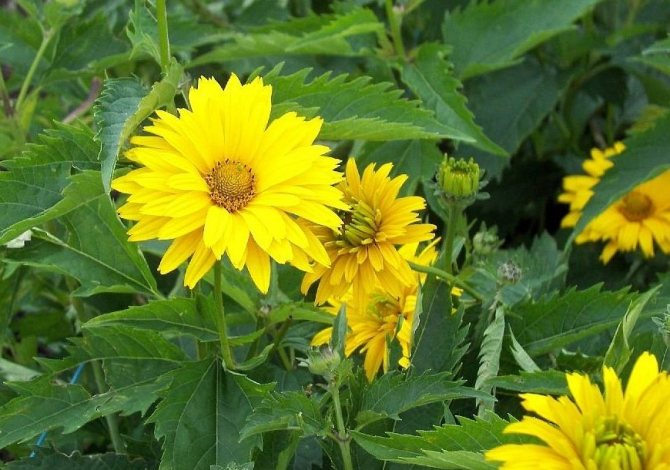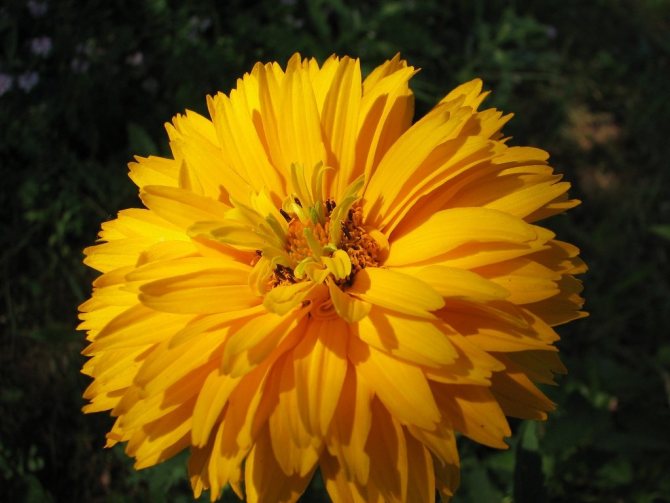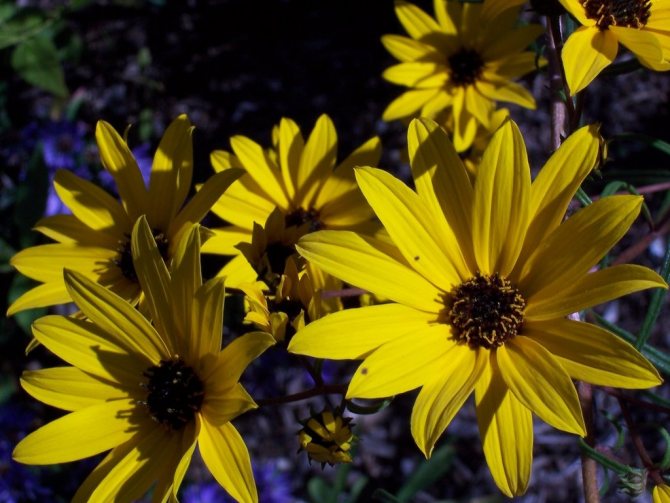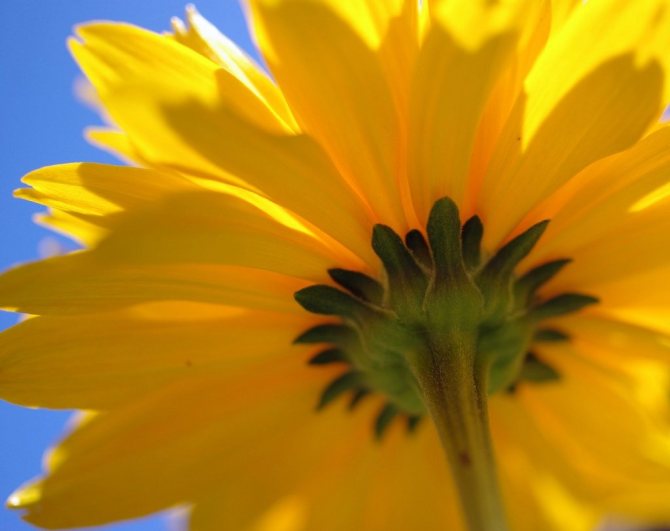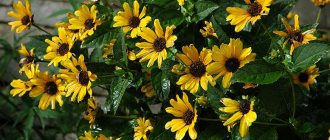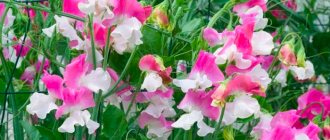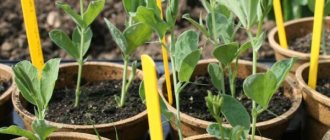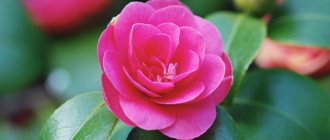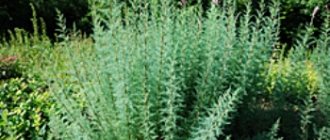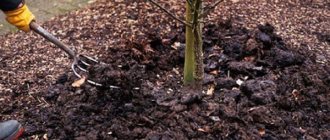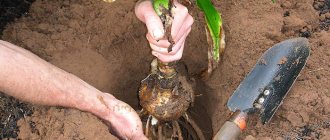Heliopsis is a sunny and joyful flower that adorns the garden in cloudy and sunny weather. The name of the flower comes from the Greek helios and opsis, which translated into Russian - similar to the sun, but its homeland is not Greece, but North America.
You can decorate a flower bed or corner of the garden with this perennial, placing it in the background, giving way to undersized flowers. Spectacular compositions are obtained by creating chaotic plantings with contrasting shades of flowers and leaves. Heliopsis blooms all summer long, does not require special care, and therefore it is doubly valuable, especially where there is no way to pay much attention to flowers.
Planting and caring for heliopsis
- Landing: sowing seeds into the ground - before winter or in the middle of spring, sowing seeds for seedlings - at the end of February, transplanting seedlings into the ground - from mid-May to early June.
- Bloom: from June for two and a half months.
- Lighting: bright sunlight.
- The soil: well drained, clayey.
- Watering: only during a prolonged drought in the morning or after sunset.
- Top dressing: from the second year, once a month with a solution of organic or mineral fertilizers for flowering plants.
- Reproduction: seeds and dividing the bush.
- Diseases: not amazed.
- Pests: aphid.
Read more about growing heliopsis below.
A beautifully flowering relative of a sunflower
Of more than a dozen known species in culture, one has become widespread - sunflower heliopsis. It was he who became the ancestor of many cultivars and hybrids.
A perennial herb belongs to the Astrovye family, forms a lush bush that grows up to one and a half meters in height. At the top of the stem, it dissolves inflorescences-baskets with a diameter of up to 9 cm from reed flowers of all shades of yellow. At the peak of flowering, their number on each plant reaches 40 pieces. Along with flowering varieties, decorative heliopsis with variegated variegated leaves, white with green veins, is gaining increasing popularity.
Bright sheaves of flowers are planted along fences, they are suitable for decorating the background of flower beds, creating volume in rabatki and mixborders. In group plantings, it is combined with annual crops in tone and contrasting colors.
Perennial Heliopsis is able to live in one place for decades, the bush grows rapidly, multiplies by self-seeding. The average duration of flowering is 2.5 months; in a warm, humid climate, flowers do not fade until frost.
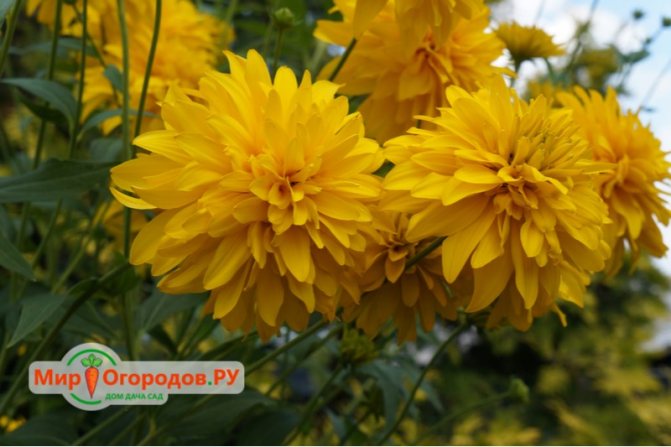
Heliopsis "Golden balls"
Growing heliopsis from seeds
Sowing heliopsis for seedlings
Planting and caring for heliopsis can begin with sowing seeds directly into the ground or with pre-growing seedlings. In the ground, heliopsis is sown in mid-spring or before winter, and for seedlings - at the end of winter. Make a substrate of equal parts of sod land, coarse sand and peat and spill it with a strong solution of potassium permanganate two weeks before sowing and cover with foil.
How to grow helenium in the garden - also a yellow flower
- Rhododendron: planting and care, growing from seeds
Before sowing, place the substrate in a container with drainage holes on top of a layer of expanded clay, evenly distribute the seeds over its surface, cover the container with a film and keep the crops under bright diffused light for the first week at a temperature of 20 ˚C, then for a month the container for stratification is kept at a temperature of 3- 4 ˚C, after which the seeds are germinated at a temperature of 25 to 28 C. The film must be regularly removed to ventilate and remove condensation from it.
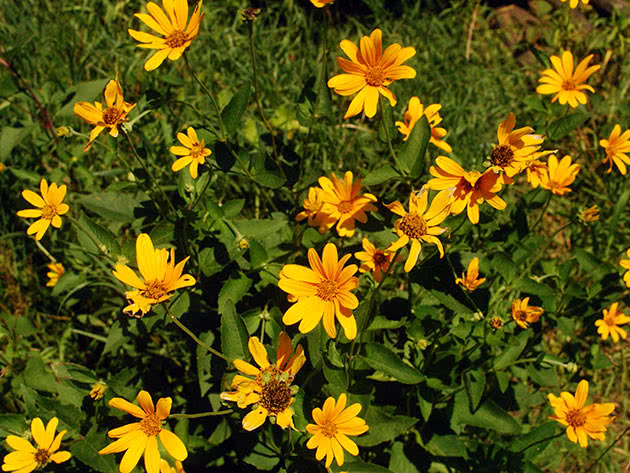

In the photo: Growing heliopsis in the flowerbed
The cover can be removed when leaves begin to appear on the seedlings, and at the stage of development of the first pair of true leaves, the seedlings dive over peat pots filled with a soil mixture of the composition already described. After picking, the seedlings are grown at a temperature of 13-15 ˚C. Seedling care consists in periodically moistening and loosening the substrate.
Planting heliopsis in open ground
When to plant heliopsis in the ground
In open ground, heliopsis is planted after the threat of return frosts has passed, that is, from mid-May to early June. Best of all, heliopsis grows in sunny areas protected from drafts in clay, but well-drained soil, for which a layer of crushed stone up to 20 cm thick is laid under the soil in a flower garden, which is covered with sand, and then the leveled drainage layer is covered with clay soil mixed with compost.
And another relative of heliopsis - coreopsis: care tips
How to plant heliopsis
Dig holes of sufficient depth in the flower garden at a distance of 30-50 cm from each other, place the heliopsis seedlings with an earthen clod in them and fill the remaining space with soil. After planting, the surface of the site is compacted and watered.
If you grow tall varieties of heliopsis, then immediately install supports for the bushes.
- Rhododendron: planting and care, growing from seeds
Reproduction
Heliopsis is propagated by dividing a bush or sowing seeds. The plant tolerates frost well, therefore, in temperate climates, seeds are sown in the fall, before the onset of frost. Seedlings appear in early spring, and bright flowers form in the summer of the first year.
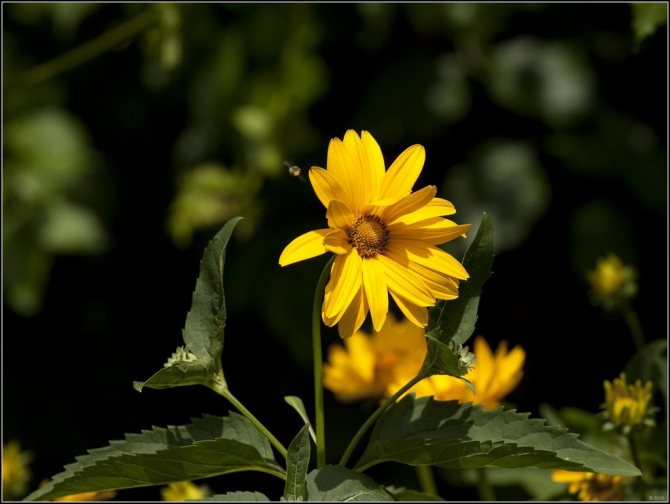

Fertile or well-fertilized soil is required for planting. Optimal use of compost and mineral fertilizers (for example, superphosphate). You can pre-grow seedlings from seeds. In order for the seedlings to be friendly, within 2-3 weeks the seeds are stratified in a refrigerator or other room with an air temperature of + 4 ° C. In March, the seeds are placed in the soil to a depth of 1 cm. A light peat substrate is used. It is recommended to immediately maintain a distance between crops of 10-15 cm. The container is kept in a warm, well-lit place until four true leaves appear. Then the seedlings dive into separate pots and begin to harden at a temperature of + 14 ... + 16 ° C. At the end of May, you can plant seedlings in a permanent place.
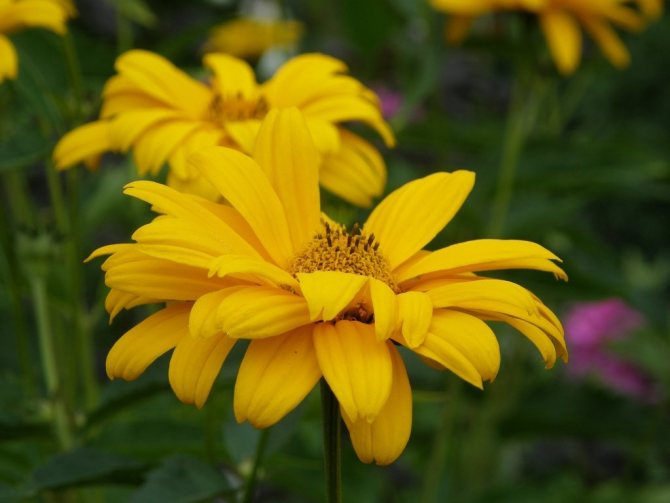

You can divide the bushes. For this, thickets with an age of 3-4 or more years are suitable. In the fall, the bush is dug up and divided into smaller ones. It is recommended to fertilize or renew the soil before planting. A distance of at least 40 cm is maintained between young plants in the garden.
Variegated varieties are propagated by cuttings. This method is more troublesome and rarely used, but it allows you to preserve varietal properties. Cuttings are cut from mid-summer and rooted in a fertile, well-drained potting medium. Transplanted into open ground next spring.
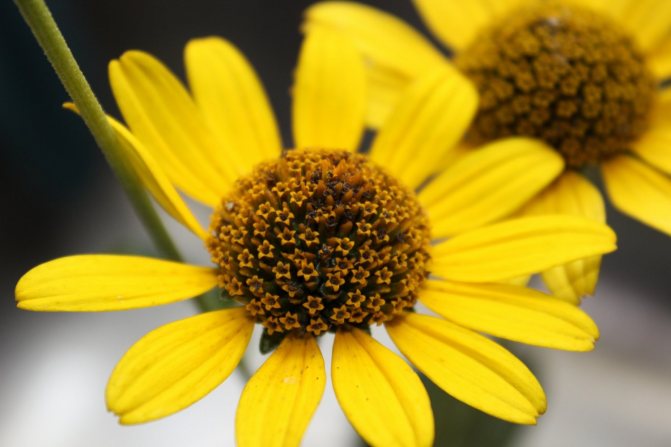

Caring for heliopsis in the garden
How to care for heliopsis
Outdoor heliopsis will require you to perform the usual procedures for any gardener. You will need to water the plant, loosen the soil around it, weed weeds in the area, pinch the tops of the shoots, stimulating tillering, remove withered and dried baskets, maintain a neat shape by pruning and tying bushes to supports, which can be metal rods, wooden pegs or metal mesh frames. Healthy and well-groomed heliopsis will bloom until mid-autumn.


On the eve of the onset of cold weather, the ground part of the plants is cut off at the very surface. The roots of heliopsis do not require shelter from frost.
Over time, heliopsis grows and can occupy areas that were planned for growing other plants. To prevent this from happening, once every 5-7 years, the bushes should be dug up, divided and transplanted to another place.
Watering and feeding heliopsis
The drought resistance of heliopsis greatly facilitates the care of this plant: it easily adapts to the heat and does not wither even in drought, however, a lack of moisture can negatively affect the duration and splendor of flowering. Therefore, water heliopsis in dry season 2-3 times a week in the early morning or after sunset with water heated in the sun, after which be sure to loosen the soil around the bushes.
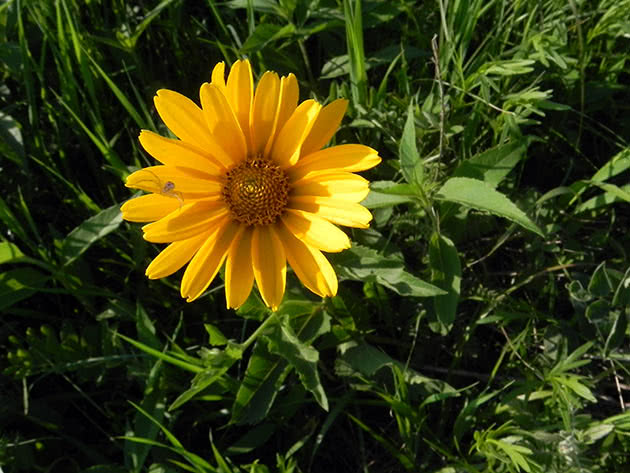

In the photo: How heliopsis blooms
From the second year, heliopsis flowers are fed once a month with organic fertilizers in line with mineral complexes for flowering plants. In the first season, heliopsis has enough nutrients laid in the soil during planting.
Pests and diseases of heliopsis
Of the pests, heliosis can be affected by black aphids. If you find a harmful insect in time, then plant extracts of nightshade, tomato, wormwood or celandine with the addition of liquid soap will help you cope with it. But if these sucking insects managed to breed, then you cannot do without the use of insecticides, and it is better to remove the most infected specimens from the flower garden and burn them altogether.


Sometimes Heliopsis can be affected by the common fungal diseases of powdery mildew and rust. Powdery mildew appears as a whitish-gray bloom on the leaves of the plant, and rust as brown spots. The infection can be destroyed by several treatments of heliopsis on the leaves with a 2% Bordeaux liquid, a solution of copper sulfate or other fungicides, for example, Fundazol.
- Rhododendron: planting and care, growing from seeds
In general, heliopsis is very resistant to both harmful insects and diseases.
Diseases and pests
The main reasons for the frequent use of heliopsis in landscape design are unpretentiousness, beauty and resistance to various diseases. Only some plant varieties are unstable to the appearance of powdery mildew and rust. The cause of these diseases is most often excessive moisture, and the causative agent is a fungus. For prevention, experts recommend treating plants with copper sulfate or foundation.
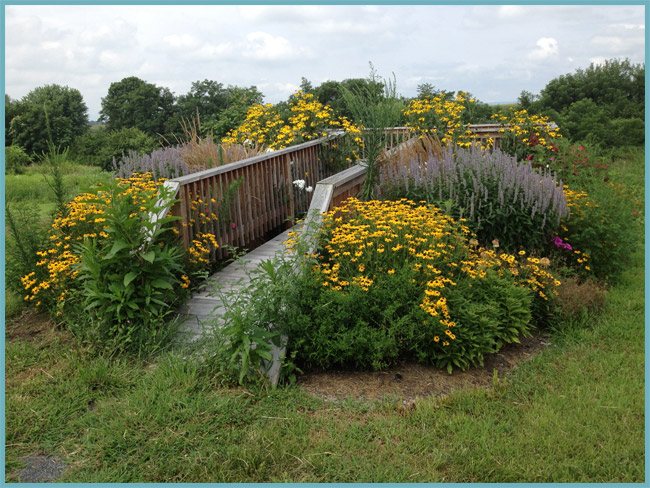

Heliopsis in landscape design
Types and varieties of heliopsis
As already mentioned, sunflower heliopsis is grown in culture, as well as its varieties, varieties and hybrids.
Sunflower Heliopsis (Heliopsis helianthoides)
or sunflower heliopsis - perennial with straight, branched and bare stems up to 1 m high, oval, pointed to the top and jagged along the edge of the leaves and golden-yellow baskets. The most popular variety in garden culture is a variety of sunflower heliopsis.
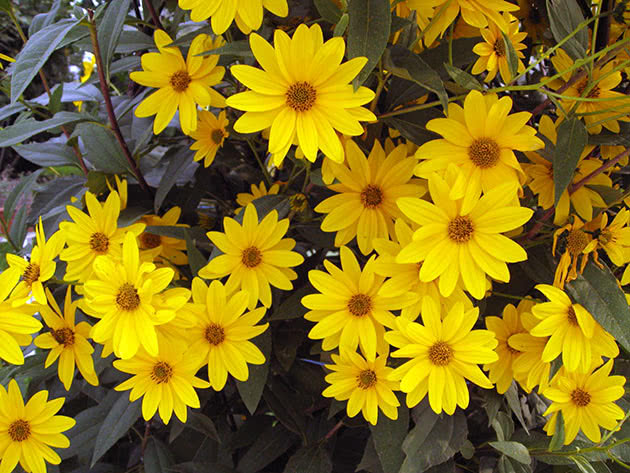

In the photo: Sunflower Heliopsis (Heliopsis helianthoides)
Description of heliopsis
The sun flower is quite tall - almost 150 m, its minimum height is 70 cm. The oblong leaves are serrated at the edges, located on the stem in different ways (opposite or alternately) depending on the type of plant. Heliopsis, a perennial or annual plant. The most popular types are heliopsis rough and sunflower.
Heliopsis scabrous Heliopsis scabra
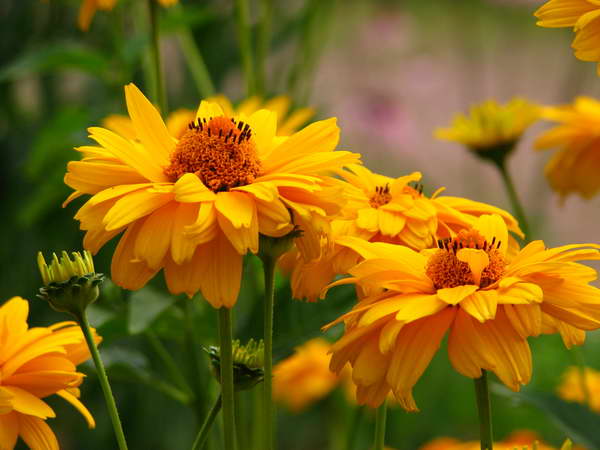

Heliopsis rough Heliopsis scabra photo of flowers
The name of the species "rough" speaks for itself, its stem and leaves are covered with coarse villi.
Heliopsis sunflower Heliopsis helianthoides
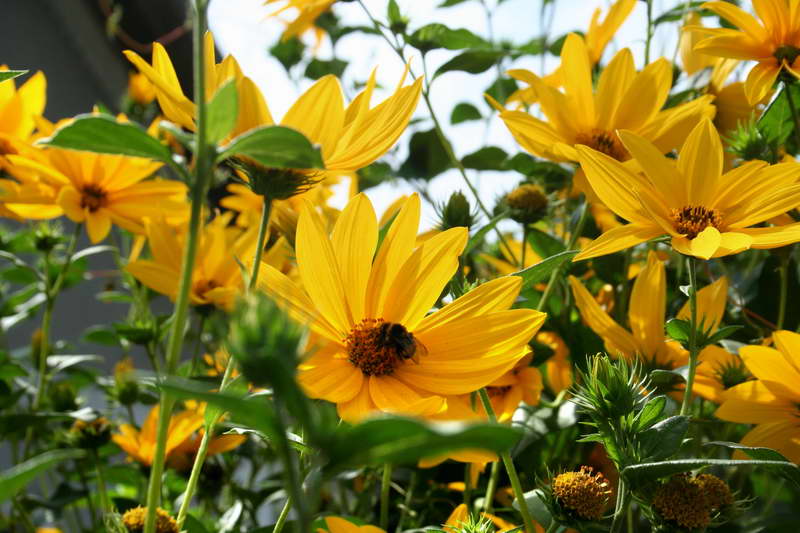

Heliopsis sunflower Heliopsis helianthoides cultivar Summer Knight Summer Nights photo of flowers
Sunflower heliopsis is distinguished by its dense flowering. The inflorescences of heliopsis are its main decoration, the petals are bright yellow, the flower is 8-9 cm in diameter. The structure of the flower depends on the variety, it can be simple, double or semi-double flowers. Heliopsis blooms almost all summer.

